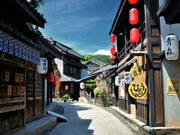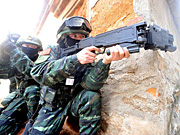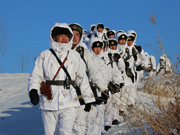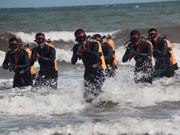 |
| Visitors take pictures of the snow view at the peak of the Seoraksan Mountain, a national park in Gangwon-do Province in South Korea. — Bob Yang |
Snow had just begun falling down when we climbed almost to the peak of South KoreaÕs Seoraksan Mountain, around 1,700 meters above sea level.
As we looked down, the world became white, snow covering all the rocks and trees. It fell gently, as though someone were throwing salt from the top of the mountain. Each tree looked like a Christmas tree, standing in stately white robes.
Seoraksan Mountain, a national park in Gangwon-do Province is famous for its red maple leaves in the autumn, but in winter, the fire-like leaves are extinguished by the snow. The temperature was minus 15 degrees, but we felt no cold because there was no wind in the valley.
The mountain is one of many in northeast South Korea and is around a 20-minute drive from downtown Seoul.
It takes around 10 minutes by cable car to reach the place where we started climbing. The carriage was filled with soft music to match the scenery.
We couldnÕt wait to rush into the fairy tale-like world, but our guide reminded us to wear gloves and scarves and prepare for low temperatures.
After we got out of the car, we continued on a wooden pathway. It was slippery and difficult to take a single step. The path was covered with ice and snow, so we held onto the handrails and trudged slowly upwards.
My friend asked, ÒDo you feel anything strange?Ó ÒYes, but why?Ó ÒIt is extremely quiet here, no twitters and no sounds of wind,Ó my friend said. He was right. The whole world seemed frozen and it felt as though time had stopped.
After staggering along the slippery paths for 20 minutes, we reached the end of the wooden steps but didnÕt have the courage to keep climbing on the natural paths. Other tourists ventured ahead and soon disappeared into the white world beyond.
The Korea Tourism Organization has just started to promote the province so now is the time to travel there before tourists swarm into the scenic land.
Gangwon-do is beautiful in all four seasons and there are activities for each time of year. In summer thereÕs an 18-hole golf course in the valleys. In winter, the mountains are transformed into a skiing paradise.
Yongpyong Ski Resort in Gangwon-do is the largest and most popular skiing site in South Korea. It has 31 slopes and 15 different lifts, including one 3.7 kilometers long.
The resort will host technical alpine skiing events for the 2018 Winter Olympics and the 2018 Winter Paralympics Games.
The resort became popular when some scenes of the 2002 Korean Broadcasting System drama ÒWinter SonataÓ were filmed at the resort. It was also a shooting location for the Seoul Broadcasting SystemÕs 2013 drama ÒThat Winter, The Wind Blows.Ó
The ski season runs from November to early April; December and January are ideal for skiing.
If you are a skilled skier, you can ride the lift to the top of the long track and ski down, or race with skiers from around the world.
But for newbies like me, itÕs best to stay at the slowest and lowest slope and begin slowly.
All equipment and clothes, including jackets and sunglasses, can be rented. Trainers are available but the basic advice is simple: Make two skis into an ÒAÓ shape, lean on your lower leg and just ski downward slowly.
ThatÕs easy, but walking back up to the top of the beginnersÕ slope is awkward, so take off the skis and trudge.
Time flies. It took five minutes to walk up and 10 seconds to ski down. We were exhausted after five runs, which took around two hours, mainly because of the difficult walking back uphill.
A small cafe at the foot of the mountain is an ideal spot for resting, recovering and sipping hot chocolate as you watch the other beginners struggle outside.
Tourists can also take the cable lift to the top of the mountain to appreciate the view and watch the experts racing each other to the foot of the mountain.
Apart from exhilarating sports, Gangwon-do also offers tranquillity. An hourÕs drive away to the west, the Naksansa Buddhist temple stands on the slopes of Naksan Mountain along the East Sea.
The temple was built in AD 671 by the monk Uisang Daesa after he returned from studying in China during the Tang Dynasty (AD 618-907). It is said Grand Master Uisang was meditating near the cave on the mountain when he saw the Avalokitesvara Bodhisattva who asked him to build the temple there.
The current pavilion was rebuilt in 1925.
We were first amazed by a small wooden house on the cliff of the mountain along the sea where the Master Uisang had meditated. In the middle of the house, the master had dug a hole through which he could see the sea churning below.
It was difficult to understand how the master remained peaceful while hearing the endless crashing of waves and rushing of tides. Nonetheless, some locals prayed inside the house and meditated.
Climbing to the top of the mountain, visitors will see the large white granite statue of Avalokitesvara Bodhisattva facing southeast. The 15-meter-tall figure stands with eyes closed and fingers clasped in meditation as it faces seaward.
Monks will greet each visitor with Zen gesture and offer free noodles inside the temple. Seeing the quiet smiles on their faces, visitors themselves feel peace in their heart.
How to get there:
It takes about five days to a week for Chinese to receive a visa at the South Korean Consulate in Shanghai. Juneyao Airlines flies direct to Gangwon-do Province every Wednesday and Saturday, landing in Gangwon-do city. The HO1307 takes off at 8:10am from Pudong International AIrport and arrives at Yangyang International Airport at 11:10am. The Korea Tourism Organization offers tour packages with Ctrip Travel Agency.

 In photos: Ten 'tuhao' devices in 2013
In photos: Ten 'tuhao' devices in 2013 Two Chinese academicians win nation's top science award
Two Chinese academicians win nation's top science award Photo story: A sommelier's life
Photo story: A sommelier's life Film and TV studios worth visiting in China
Film and TV studios worth visiting in China Heart-warming Laba porridge
Heart-warming Laba porridge Gallery: China's trapped icebreaker makes successful escape
Gallery: China's trapped icebreaker makes successful escape Archaeological study in the South China Sea: exploring the 'Maritime Silk Road'
Archaeological study in the South China Sea: exploring the 'Maritime Silk Road' Armed Police hold anti-terrorism drill in SE China's Xiamen
Armed Police hold anti-terrorism drill in SE China's Xiamen 'Red Army' division conducts winter training in N China
'Red Army' division conducts winter training in N China  Harbin Int'l Ice and Snow Festival opens
Harbin Int'l Ice and Snow Festival opens Rime scenery in Mount Huangshan
Rime scenery in Mount Huangshan 'Jin' named the word of the year by cross-strait netizens
'Jin' named the word of the year by cross-strait netizens PLA elite units unveiled
PLA elite units unveiled 
Day|Week|Month